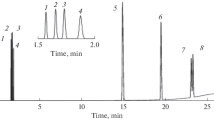Abstract
A method was developed to determine aldehydes, ketones, esters, and ethers in air which is simple, efficient, and sensitive. Analytes are trapped on a glass cartridge filled with 4 in of Porapak N followed by 1 in of charcoal. These are eluted with 1 ml of methanol, and the eluate is injected onto a gas chromatograph equipped with a photoionization detector (PID). Quantitation is performed by measuring the peak height or area of each analyte of interest and comparing it with a standard in methanol. These cartridges can be reused a number of times after reconditioning. This method is efficient since it lends itself to the use of an autosampler, which can inject large numbers of samples onto the gas chromatograph while it is unattended.
The method detection limit was from 0.6 to 16.5 μg/m3, which is comparable to other methods, and recoveries ranged from 83 to 120%. The sensitivity from highest to lowest, with respect to class of compound, was determined to be aldehydes, ketones, esters, and ethers. Up to 150 L of air can be passed onto the cartridge without any expected breakthrough of analytes, as opposed to only 10 to 30 L with 1 in of charcoal alone, which is normally the adsorbent of choice.
Similar content being viewed by others
References
Bishop WR, Valis RJ (1990) A laboratory evaluation of sorbent tubes for use with a thermal desorption gas chromatography-mass selective detector technique. J Chromatographic Science 28:589
Chan CC, Williams DT (1990) Determination of organic contaminants in residential indoor air using an adsorption-thermal desorption technique. J Air Waste Manage Assoc 40:62
Crump DR, Gardiner D (1989) Sources and concentrations of aldehydes and ketones in indoor environments in the UK. Environ International 15:455
Glaser JA, Forest DI, McGee GD, Quave SA, Budde WL (1981) Trace Analysis for Wastewaters. Environ Sci and Technol 15:1426–1430
Hang S, Yang X, Liu W (1992) The use of solid adsorbents and solvents to concentrate workplace air for the detection of volatile organic compounds by gas chromatography. Indoor Environ 1:36
Kelly TJ, Callahan PJ (1993) Method development and field measurements for polar volatile organic compounds in ambient air. Environ Sci Technol 27:1146
Kirschmer P (1992) Aldehydes in air. Analysis Magazine 20:48
Narang RS, Bush B (1980) Determination or arenes, vinyl chloride, and other volatile haloorganic compounds in water at microgramper-liter levels by gas chromatography. Anal Chem 52:2076
Sesana G, Nano G, Baj A, Balestreri S (1991) New sampling tool for airborne volatile aldehydes. Fresenius J Anal Chem 339:485
Van Tassel S, Amalfitano N, Narang RS (1981) Determination of arenes and volatile haloorganic compounds in air at microgram-per-liter levels by gas chromatography. Anal Chem 53:2130
Author information
Authors and Affiliations
Rights and permissions
About this article
Cite this article
Stein, V.B., Narang, R.S. Determination of aldehydes, ketones, esters, and ethers in air using Porapak N and charcoal. Arch. Environ. Contam. Toxicol. 30, 476–480 (1996). https://doi.org/10.1007/BF00213398
Received:
Revised:
Issue Date:
DOI: https://doi.org/10.1007/BF00213398




